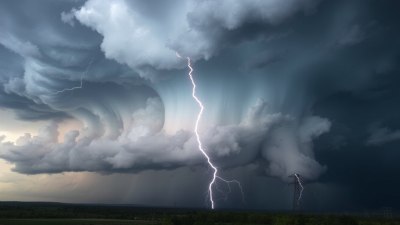Some Days You’re a Cozy Flurry, Some Days You’re Black Ice
Explore the metaphorical journey of contrasting moods and emotions that shape our daily lives.

Life is an intricate set of experiences, emotions, and moments that fluctuate from one extreme to another, often in unpredictable patterns. Sometimes, we find ourselves wrapped in a comforting embrace, much like a cozy flurry of snowflakes gently falling on a winter's day – soft, light, and warming to the spirit. Other times, we become like black ice – unseen, slippery, and treacherous, catching ourselves and others off guard with our cold demeanor or unforeseen actions. The duality of these states reflects the complex nature of human existence.
Understanding this metaphor requires a closer examination of both symbols: the cozy flurry and the black ice. Each encapsulates a unique emotional landscape and behavioral tendency, illuminating how people navigate through their personal worlds. This article explores the significance of this duality in daily life, emotional well-being, relationships, and self-awareness, offering insights on embracing both your warmth and your hidden edges.
The Cozy Flurry: Warmth in a Chilly World
Imagine a gentle snowfall—a flurry that envelops the surroundings, softening the edges of the landscape and bringing a sense of calm. This imagery conveys comfort, serenity, and a gentle presence that encourages connection and reflection. When you identify with being a cozy flurry, you embody kindness and warmth, traits that invite others to engage with you in a safe and nurturing environment.
In human interaction, being a cozy flurry means radiating empathy, patience, and a sense of protection. It's when you offer understanding instead of judgment, listen earnestly, and extend compassion freely. Such days are significant because they foster trust and deeper relationships, allowing both yourself and those around you to feel valued and supported.
Moreover, the cozy flurry state aligns with mindfulness and self-care. It is a time when you prioritize gentle activities, self-nurturing, and emotional replenishment. These moments act as healing balms to the stress and demands of modern life, reminding you of your intrinsic worth and capacity for tenderness.
Black Ice: The Hidden Challenge
In stark contrast, black ice represents the treacherous, deceptive element of a frozen surface. It's invisible until it's too late, causing potential harm and instability. Metaphorically, black ice is the part of ourselves that is unpredictable, cold, or unapproachable. These moments may reflect emotional withdrawal, unresolved anger, or defensive behavior triggered by vulnerability or stress.
When the black ice within takes hold, interactions with others may become fraught with misunderstandings or conflict. The slippery nature of black ice means that even well-intentioned actions can have unintended consequences, making it challenging to maintain balance and clarity in relationships and personal decisions.
Psychologically, experiencing black ice days highlights the necessity of addressing underlying issues rather than suppressing them. These times can signal the need to evaluate stressors, confront fears, or seek guidance for emotional regulation. Recognizing black ice within yourself is a critical step toward growth and resilience, transforming obstacles into valuable lessons.
Balancing the Flurry and the Ice Within
Most people oscillate between these states depending on various factors such as mood, environment, health, and social interactions. The key to emotional and psychological well-being is acknowledging both aspects without judgment and learning how to navigate their influences consciously.
Here are some practical strategies to manage the balance:
1. Self-awareness: Start by recognizing the signs when you lean toward either extreme. Are you feeling unusually cold, distant, or irritable like black ice? Or are you soft and nurturing like a cozy flurry? This awareness is the foundation for intentional adjustment.
2. Emotional Expression: Allow yourself to express emotions healthily. Bottling up frustration or sadness can harden into black ice, while acknowledging and sharing feelings fosters the warmth of the flurry.
3. Mindfulness Practices: Engaging in meditation or breathing exercises can calm turbulent emotions and restore equilibrium, reducing the risk of slipping into harmful black ice territory.
4. Seeking Support: Sometimes external help from trusted friends, therapists, or mentors can provide perspective and tools to manage fluctuating emotional states effectively.
5. Healthy Boundaries: Knowing when to say no or step back protects your emotional well-being, preventing exhaustion that may harden your inner landscape.
The Role of Environment and Seasons
Interestingly, the metaphor of a cozy flurry and black ice is deeply tied to environmental and seasonal elements, reflecting how our surroundings influence our internal states. Winter, for example, embodies both extremes: the peacefulness of softly falling snow and the danger lurking in invisible ice patches.
Seasonal changes can impact mood profoundly, known to trigger conditions such as seasonal affective disorder (SAD) that brings about emotional shifts akin to the metaphorical icy phase. Understanding this connection encourages proactive strategies like light therapy, outdoor activity, and social engagement to maintain emotional balance during challenging seasons.
Furthermore, physical environments that promote warmth, comfort, and safety support the cozy flurry within us. Creating spaces filled with natural light, comforting textures, and personal touches enhances feelings of emotional security and hospitality.
Relationships and Emotional Dynamics
In interpersonal relationships, alternating between being a cozy flurry and black ice is natural but must be managed carefully to maintain harmony. Transparent communication is vital; it helps others understand why you might retreat or become intense on certain days, reducing misinterpretations.
Empathy plays a two-way role here, as recognizing when someone else exhibits their black ice moments enables compassionate responses rather than reactive judgments. Cultivating patience during these phases can prevent unnecessary conflict and strengthen bonds.
Additionally, integrating rituals such as shared meals, regular check-ins, or collaborative problem-solving nurtures the cozy flurry dynamic, creating safe havens within relationships that can withstand moments of black ice tension.
Personal Growth Through Embracing Duality
Embracing the paradox of sometimes being warm and sometimes cold within ourselves offers fertile ground for personal development. It teaches acceptance of imperfection and the fluidity of human nature. Instead of striving for constant positivity or uniform behavior, acknowledging these shifts allows you to live authentically.
This acceptance encourages resilience because it frames challenges as temporary and manageable states rather than permanent flaws. People who integrate both cozy warmth and cold caution thoughtfully often experience enhanced emotional intelligence, creativity, and adaptability.
Artistic expression, journaling, or reflective practices can help illuminate this journey, providing clarity on what triggers each internal state and how to harness them constructively. For example, the cozy flurry might inspire nurturing creations or peaceful interactions, while black ice might drive boundary-setting or strategic caution.
Conclusion
Some days, you feel like a cozy flurry—soft, warm, and inviting—bringing calm and compassion into your life and the lives of others. Other days, you embody black ice, hidden and slippery, challenging yourself and your relationships with coldness or unexpected actions. Both states are essential parts of your emotional landscape and human complexity.
By acknowledging and embracing this duality, practicing self-awareness, and fostering supportive environments both inwardly and outwardly, you cultivate balance and resilience. Life’s unpredictability often mirrors winter’s contrast, but within it lies an opportunity for profound growth, connection, and self-understanding.











